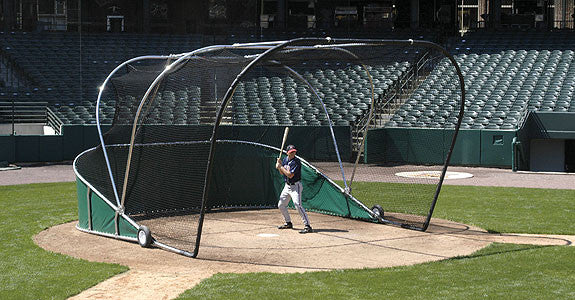Rapid Fire Ground Balls
This is a great way to end your traditional infielders’ positional work during practice. At the conclusion of your normal ground ball work at each position (third to first, short to first, second to first, 6-4-3 double play, 5-4-3 double play, 3-6-3 double play, etc.) have your infielders all gather at their respective positions and prepare them for rapid fire ground balls.
For example, your third baseman will be at his or her usual spot while the coach is hitting a fresh ground ball the split second he/she throws the ball across the diamond. This will make the fielder have a constant head on their shoulders and be prepared for whatever may come next (a ball hit to their left, hit to their right, a slow roller, a high chopper, etc.).
Since the ground balls are coming at a non-traditional rate, this will create a fun and competitive environment for your team and coaches. You’re also likely get some players that begin diving at balls and getting dirty, which will certainly get a rise from their teammates. Just make sure they’re still utilizing proper footwork and mechanics, as this drill can become a little bit chaotic.
This take time and work to get players to learn how but it is a great drill and will pay off with ball handling in the game.
CREDIT TO: thehittingvault.com
In this time of having to stay home bound players are board and on the computer for many hours. But while I advocate for them getting outside and being active there certainly are some activities that they can do on that computer that will improve their mental knowledge of the game and maybe give them insight.
Here's a few that might work for you but please encourage your player and/or yourselves to look the sites using Google or any other search engine and specific questions.
Stay mentally sharp as well as physically getting ready for baseball and softball to start.
======================
http://www.freeonlinebaseballgames.com/
====================
Try this type activity while you are home safe.
Question on how to Tag out runners in the basepaths
Bucket Drill
by Randy Huff
(Darien, CT)
Coach sits on a bucket behind pitchers mound (Honey Hole). He will roll slow rollers to either SS or 2nd base.
The drill is designed to have the middle infielders roll a double play, with each player doing a little hop after they throw the ball to first base, signifying a runner sliding into them.
The coach gets to watch how the play unfolds, like watching how the fielders field the ball, flip or throw to 2nd base and watching the small hop after the ball is released.
The coach can have a lot of fun with the drill by putting the middle infielders on a stop watch to see who can do it the fastest, kids love the drill.
Then move bucket and coach by home plate and have players go to 3rd base. Have a coach on 3rd base as a runner.
Roll ball to the players at 3rd base, make sure they look the runner back before firing ball to 1st base. Then make sure 1st baseman catches ball for out and pops off base to look at home for the play.
If the player forgets to look coach back, have coach score from 3rd. This is all explained with less than 2 outs of course.
When no one around, improve by yourself, one man drills
One of the biggest concerns that coaches and associations have these days is with pitchers and the care of their arms. Ultimately it really is the coach that needs to watch this but parents, associations, leagues, all have different thoughts and recommendations. I ran across this article from USA Today that has some nice information, and while it's not the only thing it certainly is something to consider. One side note in this conversation you as a parent must be aware of how much your son or daughter is pitching because many times a really good pitchers is playing on more than one team and therefore can accumulate more pitches than he/she should throw within a time. Because it's league is only keeping track of that one so you could even get caught up and throwing double what the boy/girl should be allowed. He was a parent need to monitor this.
I have a grandson that played in California, there league went so far as to count 35 pitches against the catcher if he came into pitch. And there league which was 14 and under if a catcher came into pitch he automatically had 35 pitches against out of the 70 possible so this is even a case of a league going a little further toward pitch count and arm care.
It is interesting to note that because of the arm motion softball pitchers can and do pitch huge number of pitches with no arm problems while we should be cautious there are no recommendations for softball, the pitcher will tell you by just looking, listening, and using common sense.
This one came from US a baseball medical and safety advisory committee: and published with their permission.
USA Baseball Medical And Safety Advisory Committee Guidelines
Age Max Pitches Game Pitches Week
8-10 50 75
11-12 75 100
13-14 75 125
15-16 90 2 Games Week
17-18 105 2 Games Week
Ages To Learn The Different Types
Pitch Type Age To Learn
Fastball 8
Changeup 10
Curveball 14
Knuckleball 15
Slider 16
Forkball 16
Splitter 16
Screwball 17
Survey Of Types Of Balls Thrown ~ Ranked Least To Most For Pain Caused
Fastball
Changeup
Curveball
Slider
Survey Conducted By Dr. Joe Chandler, Team Physician, Atlanta Braves on 101 Braves Hurlers In 2000
Dear Coach
I coach baseball at the 13-15 Babe Ruth level. We work hard with our pitchers holding runners on to avoid giving up really easy stolen bases. At this point, I think our pitchers are doing well at this task. I have a question or two about the second baseman and shortstop and their jobs of helping hold runners on at second base. I feel if we are going to give up a steal of third base, the runner that steals should at least be held on 2B properly before he earns that stolen base on us.
1) Are there different responsibilities for the two positions in regards to holding the runner at 2B vs. a left handed or right handed batter?
2) What should the footwork for the short stop and second baseman involve?
3) Should they be saying anything, tapping their gloves, or etc.?
Thanks for any tips you can offer me in regards to answering my questions.
==================================
Dear Kelly
You have this pretty well in hand and I answer that because of your suggestions and thoughts. The decision on who holes a runner at second with distractions, playing close to him, are all dependent upon the batter and where he's most likely at the ball. The general answer is whether he's left or right handed but there certainly can be exceptions as you get to know your opponents. There are several ways simply bluffing, going always a bag, living in front of the runner and backing away, moving up directly behind the runner so he knows you're there. All these things have to be done in synchronization with your pitcher so that you don't get caught out of place. Now your pitcher can help you with bluffs every once in a while, second and third looks (very is looks at the runner), pickoff plays even when there not successful which is second are pretty rare but they keep a record closer. But you are right you got to do a combination of things and you need to make sure a runner knows you're there otherwise he'll become very comfortable and get an extra step or two when the balls hit, we wants to steal, distracting your pitcher, so is a variation of what I've said and above what you said.
Coach Arnald Swift
We just came across to the new rule that's going into effect for the 2017 softball season at the NCAA level.
The dugout faces must be completely enclosed with netting or protective material all the way up to the roof line. This is for the player protection from foul balls, thrown equipment, thrown balls anything that could cause an injury entering the dugout.
I don't know that there been that many cases of injury, but there must've been something that precipitated this move and rules and move like this are not normally preventive their reactionary. I don't know what did it for my guess is there is one. Baseball and softball players are known for hanging on the dugout fence, being over it, even being outside of it and having to duck out of the way of balls flying in there.
I'm an umpire and have seen it along with being a coach for over 40 years so I don't know that it's a bad rule. The question I have for your comments is should all dugouts be protected from the ball getting into that dugout whether it be baseball, softball, no matter what the league.
I may be dating myself but I can remember dugouts that were ground-level and had no protection in front it was like sitting on a bench in a shed watching the games. Then the normal progression was to put up fences about 3 to 4 foot high to protect, then bring down lips from the top of the dugout have become standard. Now is this the evolution of dugout protection that's the question? Agree or disagree
Parents you need to kind of look at your kids coaches. A lot of coaches are just loud and still have the best of intentions for your players/children. Never allow volume to be equated with bullying, volume usually has little to do with it what you really need to know is what he says to the players and how he treats them then we may be looking at bullying.
This article could help anybody that reads it understand what is meant when bullying is talked about.
Bullying is a growing epidemic in sports. As sports parents, it's critical for you to be prepared to protect your young athletes. If you think this issue won't ever come up in your kids' sports careers, think again. Bully coaches are the number one topic parents write us about at Kids' Sports Psychology.
Have your kids ever had a coach who yelled at, insulted or intimidated them? It's possible they have, but were too embarrassed to tell you. It's important for you to be on the lookout for bully coaches and to take immediate action if you suspect your young athletes are being bullied.
Bully coaches target all kinds of young athletes. They can set their sights on kids who are overweight, small, or who lack confidence, for instance. These coaches also target gifted athletes because they believe their approach will "toughen up" their athletes.
It's important to keep in mind that most volunteer coaches are not trained. Many of them use teaching techniques that their coaches used with them. Some of them don't understand they're acting like bullies. Many coaches will change their behavior if you approach them in an appropriate manner. We've received letters of confession from coaches who say that once they understood how much their words and actions hurt their athletes, they changed their style.
Whether a coach's bullying is intentional or unintentional, your job as sports parents is the same. If your athletes are teased, excluded or otherwise treated badly by coaches, you need to take steps to help keep their confidence intact, stay focused under adversity, and remain in sports.
The bottom line, for you as parents: Be on the lookout for bully coaches and arm yourself with the information you need to take action.
Recruiting Myth
If you are good enough, college coaches will find you
This is an age-old adage that is often heard throughout the recruiting process and is both out-dated and incorrect. These words are often spoken by an older coach who wishes to dismiss any thoughts by the student-athlete or parent that they should market themselves to institutions by sending out their information. The fact is that this statement is true if you are one of the top 100 players in the country, have already received a great deal of accolades by your sophomore year, and most likely already have several scholarship offers in hand. This is simply not true for most college baseball prospects outside of the top 100. The only way they will know about you for sure is if you send them your profile and express your interest in them. Recruiting is now a global process and despite your skills or success in high school, it is extremely easy to be overlooked by college coaches who have thousands of athletes to scout and hundreds of potential venue’s to scout them at. College coaches don’t read your local town paper and they probably don’t attend your games and only the top 1% of high school athletes are truly discovered. Your performance on the field or court will go a long way toward determining whether or not you get a scholarship offer. You need to be getting results that place you near the top of your competition if you want to get noticed. However, there are other factors which will determine whether or not you get an offer including; grades, character, work ethic, coach-ability, etc. Market yourself with truth, determination, follow up, and stay after it.










